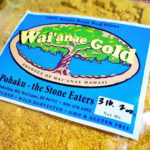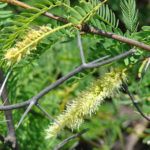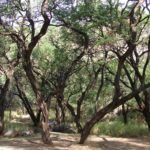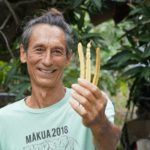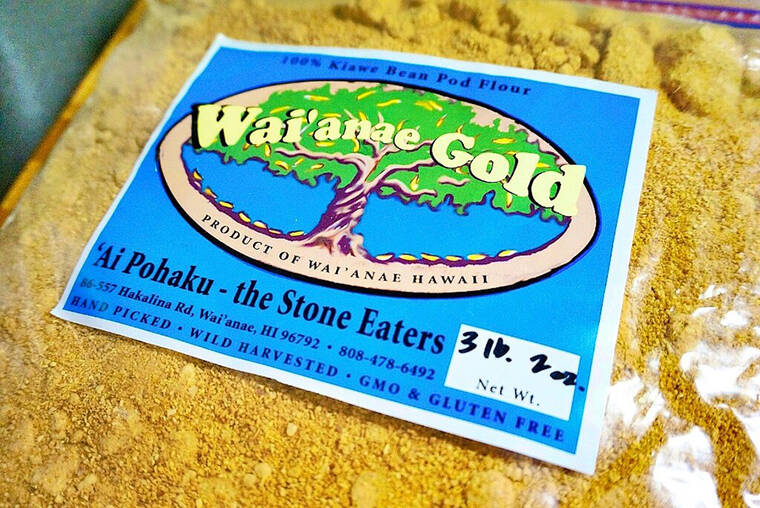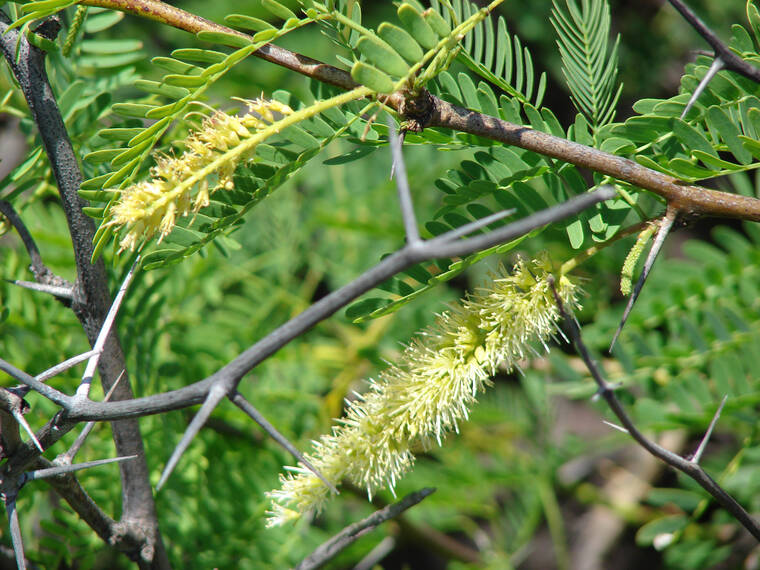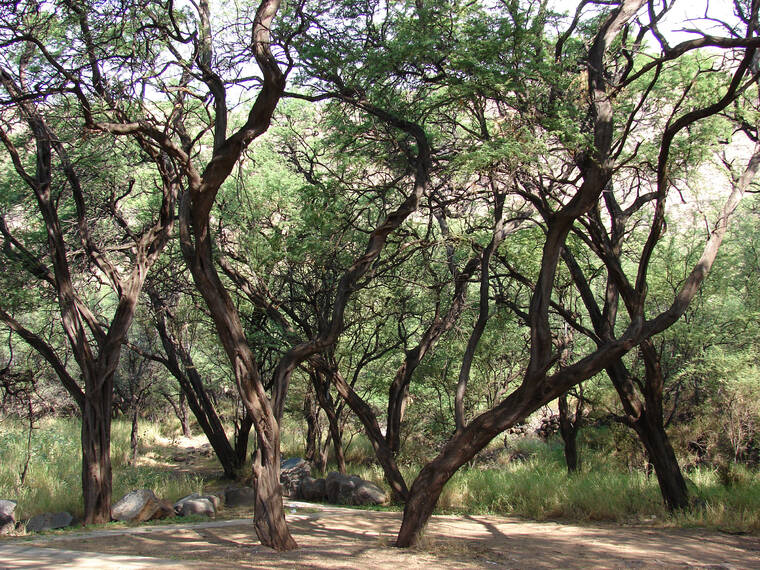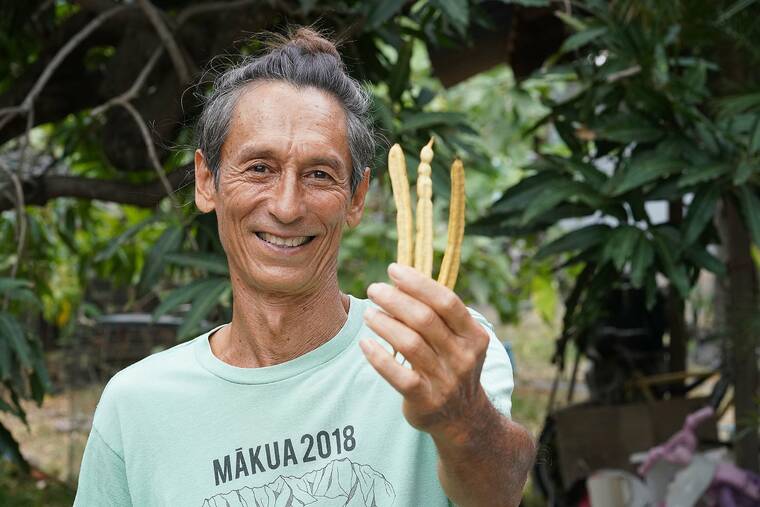In this column, I usually write about a plant you might want to grow. Though I don’t want to encourage growing a plant that can be invasive, the kiawe tree has an interesting story and many useful properties, that I’d like to share.
Known as Prosopis pallida, kiawe is a species of mesquite that is native to dry coastal areas of Columbia, Ecuador and Peru. The trees are in the Fabaceae or Bean family meaning they are able to collect nitrogen from the air to provide some of their nutritional needs. Though these trees are considered invasive here, they are threatened in their native habitats. Part of the overpopulation of kiawe here is due to the running of cattle that were fed kiawe pods once they had decimated the grasslands that formerly fed them.
Kiawe was first brought to Hawaii by Father Bachelot, who was the first Catholic priest to arrive here as a missionary. He brought kiawe seeds from the Royal Garden at Paris and presented a tree to the King in 1838. The trees propagate easily and by 1840, they were growing in over 150,000 acres on Oahu and had become the principal shade tree of Honolulu. The spread of the trees in the late 1800s was aided by the consumption of the pods and seeds by many animals that then resided within the city. Horses, mules, goats, pigs as well as cows sought out the pods for their delicious taste.
The number of trees continued to increase in the early 1900s when the U.S. Department of Agriculture imported kiawe seeds to Hawaii for reforestation efforts and to produce food for the growing livestock population. Cattle ate the pods and deposited seeds far and wide creating an invasive situation. People who lived near the kiawe forests often collected and sold the pods to supplement their income. Though many trees remain in dryland forested areas today, they are not usually grown commercially or as landscape trees.
Young kiawe trees grow quickly and can reach maturity in two years. They may grow as tall as 40 feet in ideal conditions. Once established they can live for a millennium and the interesting twists in their bark show their age. They have small green leaves and produce spikes of yellow flowers and long pods that are filled with small brown seeds.
Kiawe trees can survive in very dry locations where water tables are deep by producing long tap roots to find water. They seem to grow well in sandy, dry, and even salty soil and will even grow on degraded or rocky slopes or in disturbed areas. They sometimes provide welcome shade for understory native plants in these harsh environments.
Though a good shade tree, most kiawe trees produce long, sharp thorns that appear on fallen branches at the base of the tree. Though some thornless varieties are currently being cultivated, only about twenty percent of the wild trees are thornless.
Despite the thorns and its invasive nature, kiawe has several attractive features. The low limbs provide shade and the flowers attract bees which produce a rare and delicious white honey from the nectar. Kiawe wood can be cut to make long burning firewood and the pods are sweet and have edible appeal for many animals, including humans.
Kiawe trees reproduce easily and they can take over an area quickly. They are one of the major trees that grow wild in Wai’anae. Vince Kana’i Dodge came to know them well over the years he lived in Wai’anae.
In early 2006, Vince was at Ma’o Farms talking with Gary Nabhan and Laurie Monti from University of Arizona. Through their discussion, he learned that the seed pods of the Arizona mesquite tree were being used by the Native People of the Southwest to make a sweet, nutritious and diabetic-friendly food. Mesquite trees are a close relative of the many kiawe trees that grow in Wai’anae.
Vince reports that diabetes is endemic in Wai’anae, “I thought, this is not an accident that kiawe is growing where we have so many people with diabetes.”
This thought prompted him to begin researching a way to use the local kiawe pods to make a tasty diabetes-friendly food product for his community. In 2009, he traveled to Arizona to train in mesquite milling with Desert Harvesters.
Three years later he was off to Argentina to visit with the native Wichi people who have been consuming kiawe daily for a thousand years. He came home with a small mill that he could use to grind kiawe pods into flour. Go to waianaegold.com/original-recipe to learn more the about the adventure on Wichi ancestral land.
In July 2013, Wai’anae Gold was certified by the state Department of Health to produce Kiawe Bean Pod Flour and offer it for public consumption. To date, they are the only producers of the flour and the several products made from the flour here in Hawaii.
They continue today to mill the pods and seeds the flour that is a naturally sweet diabetic endurance food. They sell the flour as well as ‘Aina Bar cubes in both chocolate and blonde flavors. The recipe for the ‘Aina bars is inspired by a recipe used by the Wichi People. These people remove the beans from the pods and pound them into a rough flour, which they sift, add water and eat or feed to their keiki.
Vince and the team at Ai Pohaku (the Stone Eaters) added a few ingredients and were able to come up with the tasty ‘Aina Bar recipe. You can make these delicious energy bars pretty easily. Start by mixing kiawe flour with ground peanuts some honey and a touch of salt in a bowl to create a ball. Knead and fold the ball to ensure that all the ingredients are well combined.
At this point you can add chocolate chips, dried fruit or shredded coconut and roll it out onto a cookie sheet to slice into cubes. If you prefer, roll the “dough” into a log and slice pieces to eat. This recipe makes a healthy snack that is nutritious and barely sweet but requires no cooking. Cooked mashed taro or breadfruit can be used in place of peanuts if desired. More recipes are available at https://www.Wai’anaegold.com/bars-breads-cakes-mochi. Kiawe flour and Wai’anae Gold ‘Aina Bars are available by mail order from the website Waianaegold.com.
Several beekeepers have found the honey produced by bees who collect pollen from kiawe trees is thick, rich and delicious. You can view these products at www.rarehawaiianhoney.com or www.goodjobbees.com,
According to Vince, “Kiawe is a supreme gift that may well save us in this time of global warming. It provides food, medicine, shade, honey, wood and many other things. And we can easily propagate these trees.”
Although I love this story of the elevation of a weed tree’s reputation once its helpful qualities are understood, I am not recommending that we all start planting kiawe trees. Now that you know more about these trees, however, you may have a deeper respect for them and might consider growing them. Only do so if you plan to control their spread by collecting all the pods to make food. In any case, next time you see a kiawe tree you might be able to view it as a useful plant rather than a thorny weed.
Diana Duff is a plant adviser, educator and consultant living part time in Kailua-Kona.
Gardening Events
Saturdays: “Work Day at Amy Greenwell Garden” from 9 a.m. to 12:30 p.m. Meet at the Garden Visitor Center across from the Manago Hotel in Captain Cook. Come with a mask and be prepared to practice social distancing. Volunteers can help with garden maintenance and are invited to bring a brown bag lunch. Water and snacks provided. Visit the website www.amygreenwell.garden/get-involved/volunteer-1/ and sign up for the weekly email for more information on work days.
Thursday: “Worker Protection Standard Webinar” from 4 to 5:15 p.m. online. Learn how to keep yourself and your workers safe from improper use, storage, handling, application and disposal of pesticides. The current Worker Protection Standard (WPS) provisions and requirements will be covered. free to all agricultural owners, managers and their employees. Register at https://www.hawaiicoffeeed.com/wps.html.
Farmer Direct Markets
Wednesday: “Ho’oulu Farmers Market” at Outrigger Kona Resort &Spa
Saturday: “Keauhou Farmers Market” 8 a.m. to noon at Keauhou Shopping Center
“Kamuela Farmer’s Market” 7:30 a.m. to noon at Pukalani Stables
“Waimea Town Market” 7:30 a.m. to noon at the Parker School in Waimea
“Waimea Homestead Farmers Market” 7:30 a.m. to noon at the Waimea middle and elementary school playground
Sunday: “Pure Kona Green Market” 9 a.m. to 2 p.m. at Amy Greenwell Garden in Captain Cook
“Hamakua Harvest” 9 a.m. to 2 p.m. at Highway 19 and Mamane Street in Honokaa
Plant Advice Lines
Anytime: konamg@ctahr.hawaii.edu; Tuesdays and Thursdays from 9 a.m. to noon at UH-CES in Kainaliu at (808) 322-4893. Walk-in from 9 a.m. to noon Mondays, Tuesdays, and Fridays at the UH-CES at Komohana in Hilo or call (808) 981-5199 or email himga@hawaii.edu
